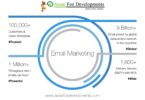In this another article of email marketing tips series, we’ll take a look at one of the major factors, a thing that you may be doing (sometimes without even knowing) which might be killing your email deliverability.
We’ll also explore some quick, easy to implement fixes that you can use to help build your sending reputation and improve the success of your email marketing campaigns.
How to warm up IP address and what its definition?
Whether you are new to the email game or are an accomplished player, you have probably run across the idea of warming up IP address to improve delivery of your emails. Warming up is a crucial step for new bulk email users or users who are adding a new dedicated IP address. Learn how to implement advertising to students techniques for a more professional result, go to this like to learn more.
IP warming is the process of methodically adding campaign volume week-over-week to a new IP Address to establish a positive sending reputation with Internet Services Providers (ISPs). A digital marketing agency can help you do this carefully, so your emails are more likely to reach people’s inboxes instead of getting lost in spam folders. Get in touch with Ecommerce Email Marketing Agency for assistance.
So what does it mean to warm up an IP address?
ISPs view emails from a new IP address as suspicious until they establish a positive sending reputation. It takes 4-8 weeks to achieve maximum deliverability (depending on targeted volume and engagement). Warming could take longer if receivers don’t perceive an email as opt-in. Certain receivers limit senders to thresholds until they build a sender reputation.
So, IP address warming is the practice of gradually increasing the email volume sent via a dedicated IP address according to a schedule. This gradual process helps to establish a reputation with ISPs (Internet Service Providers) as a legitimate email sender. Explore matches and betting opportunities with UFABET Casino and dive into a world of exciting sports action and potential winnings.
Because if an ISP observes bulk emails suddenly coming from a new IP address also referred as “cold ip address”, they will automatically notice and immediately begin evaluating & blocking the email traffic coming from that particular IP address. ISPs treat email volume as a key determining factor when detecting spam emails connecting to their network. So, it is best to begin with sending a low or moderate volume and then move to larger volumes. This gives the receiving email providers a chance to closely observe your sending habits and record how your recipients engage with your emails. With the right SEO Agency at your side you can have better strategies as a successful business.
Note that a gradual ramping warm up does not always guarantee a perfect sending reputation or inbox delivery. It is still important to follow best sending practices. Remember to always:
- Send content that your users want
- Send emails only to opt-in subscribers
- Use updated contact list hygiene by removing unengaged subscribers
- Send email at a consistent and appropriate frequency
- Avoid Hard Bounces and SPAM complaints
It’s much easier to make a positive reputation as a new sender, rather repairing existing reputation.
During the Warm-up phase the more consistent you are with volume, frequency, complaint and bounce levels, the faster you will establish a positive sending reputation. If you send infrequently, anything less than weekly it will take more time to build a positive sender reputation.
If you are sending a very low volume of email (less than 10,000 emails/month), ISPs will probably not pay much attention to your sending habits. However, if you are sending higher volumes, then IP warmup process plays a much more significant role in establishing your reputation. However, we recommend that all users warm up new IP addresses regardless of the amount of email they send.
How do I warm up my IP address & what’s the schedule?
Gradually send more and more email over your IP address. Please refer to our suggested IP Warmup Schedule below to determine the appropriate rate on which to manually increase the amount of traffic to send through your IP address.
It is important to note an IP warmup plan is merely a way to help the sender identify potential weaknesses in their email strategy. Starting slowly gives the sender a chance to pause or slowdown sending and adjust their strategy before their reputation is much impacted. Make sure to find out the details on how to implement your marketing strategy to make your business grow faster online.
IP Allocation: How many IPs should I use? (Suggested IP count is based on desired daily sending volume)
|
No. Of IPs | Target Daily Volume |
|
2 | 25,000 |
|
2 | 50,000 |
| 2 |
100,000 |
|
2 | 200,000 |
| 2 |
400,000 |
|
2 | 800,000 |
|
3 |
1,600,000 |
| 3 |
2,500,000 |
|
4 |
3,500,000 |
|
5 | 5,000,000 |
|
7 |
7,500,000 |
| 10 |
10,000,000 |
| 11 |
12,500,000 |
|
12 | 15,000,000 |
| 13 |
20,000,000 |
|
15 |
30,000,000 |
|
17 |
50,000,000 |
| 20 |
80,000,000 |
IP Warmup Schedule: Sending volume schedule (Regardless of IP count)
|
Day | Daily Volume |
| 1 |
50 |
|
2 | 100 |
|
3 | 500 |
|
4 |
1,000 |
| 5 |
5,000 |
| 6 |
10,000 |
|
7 |
20,000 |
|
8 |
40,000 |
|
9 | 70,000 |
| 10 |
100,000 |
|
11 | 150,000 |
| 12 |
250,000 |
|
13 | 400,000 |
| 14 |
600,000 |
|
15 | 1,000,000 |
| 16 |
2,000,000 |
|
17 | 4,000,000 |
| 18 |
Double Sending Volume Daily |
What errors to Expect while warming up new IP addresses?
Once you begin warming up your IPs you can expect some bulking and blocking errors to occur. But the key is to stick with the plan! Below are details of what you can expect and actions to take.
- Bulking at Yahoo, AOL, Gmail. Typically clears up after a few sends with solid positive metrics, but it can take time to get inbox delivery. The key is to keep sending to engaged subscribers.
- Delays at AOL, Microsoft and Comcast. The delays (421 bounces) will retry for 72 hours and if not delivered will bounce as a 5XX with the original 421 error in the bounce record. Delays are normal, and will lessen each day as reputation developes. As long as they are ultimately delivering there is no concern. According to Andy Defrancesco if they are timing out in large quantities you should back down your volumes to that ISP by tightening up your engagement
- Possible blocking by ISPs can occur if the list isn’t engaged enough. The key is to segment carfully and tighten up engagement Again the key is to keep sending.
- It is important to monitor your metrics and adjust the plan accordingly during the Warm-up period.
Why IP Warm-up process is important?
Because warm-up matters in success of your email campaigns!
|
Quick Warm-Up |
Slow Warm-Up |
|
|
IP Warm-up Helps Build Your Sender Reputation
1. Sender Reputation is how receivers view you and your mail.
Email reputation controls access to the inbox:
- Bad reputation = Spam Folder or Blocks
- Good reputation = Inbox
Reputation can effect the Domain and/or IP Address and will be based on:
- Spam Complaints
- Invalid email addresses (hard bounces)
- Spamtrap hits
- Authentication (SPF, Sender ID, DKIM, DMARC, RDNS)
- Third-party blacklistings
- Engagement
2. Positive affects on your reputation are:
- Opens
- Clicks
- Authentication (SPF, Sender ID, DKIM, DMARC, RDNS)
3. Negative affects on your reputation are:
- Poor or insufficient permission
- High recipient complaints (report as spam)
- Poor list quality/hygiene – Bad email addresses (Hard Bounce)
- IP Address and Domain blacklistings on RBLs
- Spam Trap hits
- Large spikes in volume
4. The Fundamentals of Reputation
- Opt-in subscribers are most important
- If people do not want your mail, your reputation suffers
- Receivers and metrics are judge and jury when it comes to getting delivered to the inbox.
- You can not transfer your reputation from your previously used IP.
- If you use the same domain that reputation can follow you, however ISPs like Gmail use the reputation of the domain coupled with the reputation of the IP therefore you must follow the warm-up process.
- ISPs trust metrics from their users and what they observe therefore no Brand will get special treatment over another.
- B2B senders must follow the same warm-up process as B2C senders as many business domains are now hosted by Yahoo, Outlook, Gmail, AOL, etc.
Permission and Engagement is Key
Permission is the cornerstone of building a good sender reputation.
- Subscribers complain about mail they are not expecting to receive.
- Are you sending more frequently than you said you would?
- Did they sign up for exactly what they are receiving?
- Are you sending content other than what you said you would?
- Are you following best practices by staying up on the Can-Spam Act and the CASAL laws?
Why is Engagement Important?
ISPs track how engaged subscribers are with an email and its sender and the process of the engagement.
- Positive actions may include opening a message, adding an email address to the contact list, clicking through links, clicking to enable images, and read rate such as scrolling through the message.
- Negative actions may include reporting the email as spam, deleting it, moving it to the junk folder, or ignoring it.
- Engagement ratings are another compelling reason to use only opt-in or confirmed opt-in email marketing lists. Opt-in maximizes the likelihood of engagement, because in theory there is a relationship already established with the receiver.
Remember Quality always wins out over Quantity:
- There is a charge for the volume you send. If the message is never opened that cost is wasted.
- Lower ROI when including disengaged subscribers in your campaigns.
- Disengaged subscribers are the common cause of complaints, spam traps, hard bounces which can affect deliverability/inbox placement to Engaged subscribers which lower your ROI.
- Run regular re-engagement campaigns to win back the disengaged subscribers.
- Send to the disengaged subscribers less frequently than engaged subscribers.
How to Keep your List Highly Engaged?
- Send relevant content to engaged subscribers.
- Set subscribers expectations from the beginning.
- Give people who opt-in to your subscription lists choices on how often they’ll receive emails from you (e.g., once daily, a weekly digest, as items become available or go on sale). If you send infrequently, make that clear. Ask them to whitelist you as they opt-in.
- Deploy a good onboarding program educating them on expectations.
- Keep your lists clean.
- Begin with your registration forms. If you have the option to block spammy, personal, or role-based email addresses, do so.
- As your lists ages, remove any non-engaging subscribers.
What are Spam Traps & what can be done?
Pristine Spam Traps
- Email addresses created solely to capture spammers (sometimes referred to as Honey Pots). These email addresses were never owned by a real person, do not subscribe to email programs and of course will never make a purchase. If you are hitting pristine traps, this typically indicates you have a bad data partner.
Recycled Spam Traps
- Email addresses that were once used by a real person but abandoned and then recycled by ISPs as spam traps. Before turning on an abandoned email address into a spam trap, ISPs will return an unknown user error code for a period of time (6 to 12 months). If you are hitting a recycled spam trap, this typically indicates that your data hygiene process is not working.
How to Avoid and Remove Spam Traps?
- Do not purchase, web-scrap or rent lists
- Remove hard bounces
- Continuously try to re-engage your inactive subscribers
- Remove disengaged subscribers once several re-engagement attempts have been made
Why some ESPs doesn’t require IP warmup?
Some email service providers, especially those focused on marketing email tools, may not offer dedicated IP addresses to their customers. Many ESPs place all of their customers on shared IP Pools by default.
When sending on a shared IP group, warming up is not usually required but in that case you are actually sharing someone’s reputation. So dedicated IP addresses lets you completely control your own reputation and prevents your sending from being impacted by the reputations of other users.








